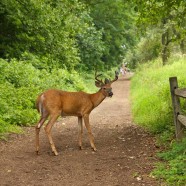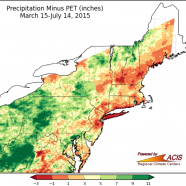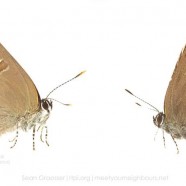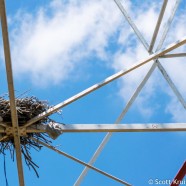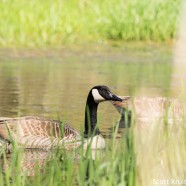Close-up Deer
This picture by RTPI Affiliate Sean Graesser shows us what we do not want to see. This White-tailed Deer should have a lot more fear of humans, and their overpopulation in many areas is a leading factor in the continuing degradation of our forest understory habitat, especially in consideration of nesting bird species. Apples certainly are a tasty treat, but this is a wild animal, not a petting zoo!
Read MoreMoisture Levels
Mosquitoes bothering you lately? Or have they been fewer in number than normal? Depending on your location in the Northeast you likely have differing answers. This map shows the precipitation minus the precipitation evapotranspiration, the total of evaporation and plant transpiration of water from the Earth’s surface. Preliminary research by the Northeast Regional Climate Center and Cornell Entomology “indicates that adult mosquitos (Culex) populations are typically high during periods of time when precipitation exceeds evaporation”, which are the positive values shown. The...
Read MoreBanded vs. Hickory Hairstreaks
It’s been a great year so far for the Banded Hairstreak (Satyrium calanus) says Sean. He can typically walk around right now in favorable areas and find four or five. Recently while out walking at Audubon Greenwich he spotted a Hickory Hairstreak (Satyrium caryaevorus), a difficult hairstreak to find and get a confident identification of in Connecticut. He put together a comparison of the two to help with some of the small diagnostic differences. Photographed by RTPI Affiliate Sean Graesser for the Meet Your Neighbours global biodiversity project in Connecticut while on assignment for...
Read MoreTowering Osprey
Can you identify this photo’s distant subject? That Osprey and its mate have built a nest in what looks like an optical illusion or mind maze, but in reality is a massive radio tower. It is a wonderful thing that the species’ comeback has been so successful in the last several decades that they are now relegated to using any bare structure they can find. I certainly would worry about it up there during a thunderstorm, for a few reasons, but having an abundant breeding population is one of those good problems. Even if these individual birds are not successful this season you can...
Read MoreCanada Goose Pair
There is no more common and known waterfowl species than the Canada Goose (Branta canadensis) for most of us year-round, but even this bird, seen as a pest by some as they soil parks and cover golf courses, must live and breed. This is a pair at a local pond that was likely about to nest. They really have a handsome look to them, if you stop to take it in…and I appreciate them! Scott Kruitbosch Conservation & Outreach Coordinator
Read More



